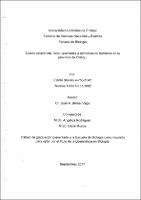Mostrar el registro sencillo del ítem
Acaros (Arachnida: Acari) asociados a domicilios de humanos en la provincia de Chiriquí.
| dc.contributor.advisor | Rodríguez, Angelica | |
| dc.contributor.advisor | Murcia, Osiris | |
| dc.contributor.author | Estribí, Sherley | |
| dc.contributor.author | Recinos, Addis | |
| dc.date.accessioned | 2023-09-07T13:42:07Z | |
| dc.date.available | 2023-09-07T13:42:07Z | |
| dc.date.issued | 2017-09 | |
| dc.identifier.uri | http://jadimike.unachi.ac.pa/handle/123456789/889 | |
| dc.description.abstract | Con el objetivo principal de determinar la diversidad y abundancia de ácaros en los Domicilios humanos, se realizaron tres muestreos durante 2014, en los meses de mayo, agosto y noviembre, en casas de dos distritos de la provincia de Chiriqui: Boquete (tierras altas) y David (tierras bajas). Se recolectaron las muestras utilizando un método que Consistió en barrer con brochas todo el polvo en un área de un metro cuadrado debajo de la camal las muestras fueron colocadas en bolsas plásticas y trasladadas al laboratorio en hieleras. En el laboratorio, se procedió a tomar una submuestra de 0.1 g de polvo y se le aplicó la técnica de flotación para separar los Ácaros de otras partículas Presentes en el polvo. En total se obtuvieron 85 muestras de polvo, de las cuales se identificaron 1 137 individuos pertenecientes a 17 géneros, 17 familias, en cuatro 6 rdenes de ácaros. La especie Typhlodromus Transvaalensis fue el mas representativo en David con una abundancia relativa de 29.75 mientras que la especie más representativa en Boquete fue Dermatophagoides pteronyssinus con una abundancia relativa de 35.64 %. El sitio con mayor abundancia fue Boquete con 896 individuos que representan el 78.00% del total del estudio, mientras que en David 242 individuos que representan el 22.00 % restante. El sitio de mayor riqueza fue Boquete, con 24 especies, tres más que en David La densidad promedio en David fue de 66 acaros/gramo de polvo, mientras que en Boquete fue de 228 acaros/gramo de polvo. EL induce de similitud de Sorensen cuantitativo fue de 0.17. Lo que reflejó baja similitud entre Boquete y David, posiblemente reflejo de las diferencias en temperatura y humedad de cada localidad. | |
| dc.description.abstract | With the main objective of determining the diversity and abundance of mites in the human dwellings, three samples were taken during 2014, in the months of May, August and November, in the houses of two districts of the province of Chiriqui: Boquete (highlands) And David (lowlands). The samples were collected using a method that consisted of sweeping allthe dust in an area of one square meter under the bedIThe samples were placed in the plastic bags and transferred to the laboratory in ice chests. Already in the laboratory, a sample of 0,1 g of dust was taken and flotation technique was applied to separate the scopes of other parts in the powder. In total, 85 dust samples were obtained, of which 1 137 individuals belonging to 17 genera. 17 families, in four orders of mites were identified. the most representative in David with a relative abundance of 29.75 %l while the most representative at Boquete was Dem7afophago/des pfennigs/nus with a relative abundance of 35.64 %. The site with the mayor abundance was Boquete with 896 individuals representing 78.00 % of the total study, while in David 242 individuals representing the remaining 22.00 %. The site of greatest wealth was Boquete, with 24 species, three more than in David. The mean density in David was 66 mites / gram of dust, while in Boquete it was 228 mites / gram of dust. The similarity index of quantitative simulation was O.17, which reflected the low similarity between Boquete and David, possibly reflecting the differences in temperature and humidity of each locality. | |
| dc.language.iso | es | es_ES |
| dc.publisher | Universidad Autónoma de Chiriquí | es_ES |
| dc.subject | TESIS - BIOLOGÍA | es_ES |
| dc.subject | ACAROS VECTORES | es_ES |
| dc.title | Acaros (Arachnida: Acari) asociados a domicilios de humanos en la provincia de Chiriquí. | es_ES |
| dc.type | Thesis | es_ES |

